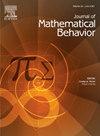The semiotic potential of pseudo-random numbers for the idea of indeterminacy in algebra
IF 1.7
Q3 EDUCATION & EDUCATIONAL RESEARCH
引用次数: 0
Abstract
This article is focused on the potential of spreadsheets to foster the transition from arithmetic to algebra in students who have not yet been exposed to formal algebra instruction. We study the potential of the pseudo-random number generator functionality of spreadsheets with the theory of semiotic mediation. Results are reported from a teaching sequence in which 6th-grade students (aged 11–12) are given tasks in spreadsheets incorporating this functionality. We analyze the artefact signs produced by a pair of students while solving the tasks, in terms of the processes pointed out by Radford as distinguishing features of algebraic thinking: addressing indeterminacy, denoting indeterminate numbers and operating on indeterminate numbers. In light of this analysis, we discuss the actual unfolding of the hypothesized semiotic potential of the pseudo-random number generator functionality, together with difficulties and cautions emerged, as well as possible refinements in the design of future iterations of the intervention.
伪随机数在代数不确定性思想中的符号学潜力
本文的重点是电子表格的潜力,以促进学生从算术到代数的过渡,谁还没有接触到正式的代数教学。利用符号中介理论研究了电子表格伪随机数生成器功能的潜力。结果报告了一个教学序列,其中六年级学生(11-12岁)在包含该功能的电子表格中分配任务。我们分析了一对学生在解决任务时产生的伪符号,根据Radford指出的作为代数思维特征的过程:处理不确定性,表示不确定数和操作不确定数。根据这一分析,我们讨论了伪随机数生成器功能的假设符号学潜力的实际展开,以及出现的困难和注意事项,以及在干预的未来迭代设计中可能的改进。
本文章由计算机程序翻译,如有差异,请以英文原文为准。
求助全文
约1分钟内获得全文
求助全文
来源期刊

Journal of Mathematical Behavior
EDUCATION & EDUCATIONAL RESEARCH-
CiteScore
2.70
自引率
17.60%
发文量
69
期刊介绍:
The Journal of Mathematical Behavior solicits original research on the learning and teaching of mathematics. We are interested especially in basic research, research that aims to clarify, in detail and depth, how mathematical ideas develop in learners. Over three decades, our experience confirms a founding premise of this journal: that mathematical thinking, hence mathematics learning as a social enterprise, is special. It is special because mathematics is special, both logically and psychologically. Logically, through the way that mathematical ideas and methods have been built, refined and organized for centuries across a range of cultures; and psychologically, through the variety of ways people today, in many walks of life, make sense of mathematics, develop it, make it their own.
 求助内容:
求助内容: 应助结果提醒方式:
应助结果提醒方式:


